 AppDynamics, Inc., of San Francisco, CA, is a private tech company focused on providing application performance management and analytics in the growing application intelligence sector. The company has garnered some attention as a result of its latest round of funding, announcing in late November that it had raised $158 million from venture capital sources for a total of $315 million in financing since the company was founded in 2008. Reports on the deal indicate that the successful funding round helped AppDynamic’s valuation to surge from $1.1 billion up to $1.9 billion. AppDynamics saw about $150 million in gross revenue during 2014 and currently serves 1,600 paying customers including Kraft, NASDAQ, eHarmony and Nike.
AppDynamics, Inc., of San Francisco, CA, is a private tech company focused on providing application performance management and analytics in the growing application intelligence sector. The company has garnered some attention as a result of its latest round of funding, announcing in late November that it had raised $158 million from venture capital sources for a total of $315 million in financing since the company was founded in 2008. Reports on the deal indicate that the successful funding round helped AppDynamic’s valuation to surge from $1.1 billion up to $1.9 billion. AppDynamics saw about $150 million in gross revenue during 2014 and currently serves 1,600 paying customers including Kraft, NASDAQ, eHarmony and Nike.
Recent updates to AppDynamics software programs now allow website owners to identify the exact location of a networking issue at an exact point of the network’s infrastructure, quickly notifying users of a downed server or overloaded CPU causing a website to go down. AppDynamics is also increasing its collaboration with open source software provider Red Hat (NYSE:RHT) to build application intelligence into some of Red Hat’s products, including OpenShift and JBoss Middleware. At the end of November, AppDynamics’ 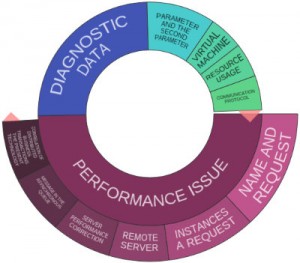 AppSphere 2015 event got underway; the company’s second annual user conference brought in 1,500 attendees looking to learn more about application performance monitoring.
AppSphere 2015 event got underway; the company’s second annual user conference brought in 1,500 attendees looking to learn more about application performance monitoring.
AppDynamics is an example of what is known in the venture capital world as a “unicorn,” a start-up company that reaches a valuation that exceeds $1 billion. In early November, IPWatchdog ran an article describing that nearly one-third of unicorns had no intellectual property assets. Thanks to the patent portfolio analysis tools available through Innography, we can see that this start-up actually holds a portfolio of 9 U.S. patents and 22 patent applications filed at the U.S. Patent and Trademark Office. As the text cluster posted here shows, much of this company’s research and development has focused on performance issues as well as diagnostic data.
While a 9 patent portfolio is not by any means a large portfolio, particularly given the lofty $1.9 billion valuation, we thought it might be interesting to take a look under the hood to see what a unicorn with patents has for a patent portfolio. With that in mind, what follows is a thumbnail sketch of the AppDynamics patent portfolio and discussion of a couple of interesting pending patent applications that caught our eye.
[Varsity-2]
AppDynamics Issued Patents: Heavy IP Focus on Monitoring Distributed Applications
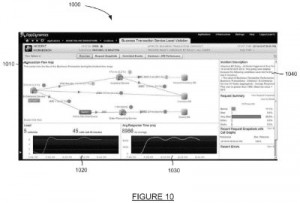 The application monitoring and analytics technologies innovated by AppDynamics can perhaps be better understood by taking a close look at U.S. Patent No. 9015317, entitled Conducting a Diagnostic Session for Monitored Business Transactions. It protects a method for performing a diagnostic session for a request by monitoring the request at a server, detecting an event associated with the request, initiating a diagnostic session in response, collecting diagnostic data by sampling an application thread associated with a business transaction on two or more servers and storing the thread call stack state data. This system is designed to improve performance monitoring for distributed applications by detecting anomalies based on learned behaviors of the distributed network application system. Web services for monitoring distributed applications are also at the center of U.S. Patent No. 9167028, which is titled Monitoring Distributed Web Application Transactions. It discloses a method for monitoring a business transaction which involves associating a received request with a thread that handles the request, associating the thread with a monitoring parameter, modifying thread data with a section of a call chain identifying two or more computers or services processing a business transaction, modifying an external request with the monitoring parameter and reporting runtime data associated with the received request to a first server. This business transaction monitoring system is designed with efficiencies that enable it to be implemented in cloud and virtual systems with a low footprint. Transaction monitoring systems which are designed to be easily deployed in distributed networks are the focus of U.S. Patent No. 9015315, titled Identification and Monitoring of Distributed Business Transactions. This patent discloses a method for identifying a transaction by receiving a request associated with a distributed transaction from a remote application, detecting data associated with the request or code executed when processing the request and associated with call chain data identifying a sequence of computers that have processed that request, identifying a distributed type based on the detected request data or executed code, associating a distributed transaction identifier based on associated request data and associating monitoring parameters with a local thread memory based on the identified transaction type. This innovation is designed to provide better monitoring for an application without dealing with the impracticalities of collecting large amounts of data generated by each machine utilized in a distributed application network.
The application monitoring and analytics technologies innovated by AppDynamics can perhaps be better understood by taking a close look at U.S. Patent No. 9015317, entitled Conducting a Diagnostic Session for Monitored Business Transactions. It protects a method for performing a diagnostic session for a request by monitoring the request at a server, detecting an event associated with the request, initiating a diagnostic session in response, collecting diagnostic data by sampling an application thread associated with a business transaction on two or more servers and storing the thread call stack state data. This system is designed to improve performance monitoring for distributed applications by detecting anomalies based on learned behaviors of the distributed network application system. Web services for monitoring distributed applications are also at the center of U.S. Patent No. 9167028, which is titled Monitoring Distributed Web Application Transactions. It discloses a method for monitoring a business transaction which involves associating a received request with a thread that handles the request, associating the thread with a monitoring parameter, modifying thread data with a section of a call chain identifying two or more computers or services processing a business transaction, modifying an external request with the monitoring parameter and reporting runtime data associated with the received request to a first server. This business transaction monitoring system is designed with efficiencies that enable it to be implemented in cloud and virtual systems with a low footprint. Transaction monitoring systems which are designed to be easily deployed in distributed networks are the focus of U.S. Patent No. 9015315, titled Identification and Monitoring of Distributed Business Transactions. This patent discloses a method for identifying a transaction by receiving a request associated with a distributed transaction from a remote application, detecting data associated with the request or code executed when processing the request and associated with call chain data identifying a sequence of computers that have processed that request, identifying a distributed type based on the detected request data or executed code, associating a distributed transaction identifier based on associated request data and associating monitoring parameters with a local thread memory based on the identified transaction type. This innovation is designed to provide better monitoring for an application without dealing with the impracticalities of collecting large amounts of data generated by each machine utilized in a distributed application network.
 Monitoring systems capable of learning the behaviors of networks to better identify anomalies are also described within U.S. Patent No. 8938533, entitled Automatic Capture of Diagnostic Data Based on Transaction Behavior Learning. It protects a method for monitoring a business transaction by accessing runtime data including aggregated performance data and associated with a request executing on a server, executing a module by a processor to determine an anomaly associated with the request based on the runtime data, sampling a second thread running on the server associated with a subsequent instance of the request associated with the anomaly, sampling a second thread call stack, updating a thread call stack snapshot based on the call stack samples collected for the second thread and reporting the sampled thread data. This automatic collection of diagnostic data provides accurate and efficient monitoring of the performance of distributed applications to report anomalies through a user interface. Efficiencies in application performance monitoring are also sought by the technology detailed within U.S. Patent No. 9037707, entitled Propagating a Diagnostic Session for Business Transactions Across Multiple Servers. It claims a method for monitoring a distributed transaction including detection of a diagnostic event by associating a diagnostic identifier with the request in response to the event, sampling a thread call stack handling the request at a first server, detecting an outgoing call at the first server associated with processing the request and modifying the outgoing call at the first server to include the diagnostic identifier and a call chain of a sequence of servers that have processed the distributed transaction. This method also utilizes network behavior learning techniques in order to automatically collect diagnostic data for business transactions or other requests.
Monitoring systems capable of learning the behaviors of networks to better identify anomalies are also described within U.S. Patent No. 8938533, entitled Automatic Capture of Diagnostic Data Based on Transaction Behavior Learning. It protects a method for monitoring a business transaction by accessing runtime data including aggregated performance data and associated with a request executing on a server, executing a module by a processor to determine an anomaly associated with the request based on the runtime data, sampling a second thread running on the server associated with a subsequent instance of the request associated with the anomaly, sampling a second thread call stack, updating a thread call stack snapshot based on the call stack samples collected for the second thread and reporting the sampled thread data. This automatic collection of diagnostic data provides accurate and efficient monitoring of the performance of distributed applications to report anomalies through a user interface. Efficiencies in application performance monitoring are also sought by the technology detailed within U.S. Patent No. 9037707, entitled Propagating a Diagnostic Session for Business Transactions Across Multiple Servers. It claims a method for monitoring a distributed transaction including detection of a diagnostic event by associating a diagnostic identifier with the request in response to the event, sampling a thread call stack handling the request at a first server, detecting an outgoing call at the first server associated with processing the request and modifying the outgoing call at the first server to include the diagnostic identifier and a call chain of a sequence of servers that have processed the distributed transaction. This method also utilizes network behavior learning techniques in order to automatically collect diagnostic data for business transactions or other requests.
The monitoring systems developed by AppDynamics have the capability to dynamically scale itself, a feature which is discussed in U.S. Patent No. 9015278, titled Transaction Correlation Using Three Way Handshake. It discloses a method for communicating data between servers by detecting at a first computer a request to a second computer, sending the request and an unknown service identifier identifying the second computer to the second computer, transmitting the unknown service identifier and the request information to a server from the first computer and receiving the second computer identifier from the server. The resulting system achieves an easy deployment as well as dynamical scaling capability across a monitored system.
[Varsity-3]
Patent Applications of Note: From Performance Monitoring Interfaces to Determining End-User Timing
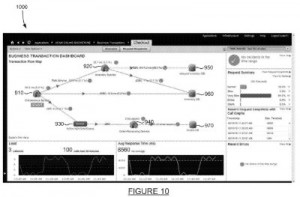 The naming of transactions, like “add to cart” or “checkout” transactions, for application monitoring services is made easier through the technology outlined within U.S. Patent Application No. 20150237119, entitled Naming of Distributed Business Transactions. It would protect a method for identifying a transaction by receiving a request associated with a distributed transaction from a remote application, detecting data associated with the request and generating a distributed transaction identifier based on the data. The system helps application managers better determine what kind of transaction is being monitored to more quickly troubleshoot issues. Better user readability in application performance monitoring systems is also featured within U.S. Patent Application No. 20150301877, which is titled Naming of Nodes in Net Framework. It claims a method for monitoring a business transaction which involves detecting a call by an application on a first remote server to a node on a second remote server, determining whether to monitor the call to the node and automatically generating a name for the node including a name of the machine on which the node resides. The innovation is intended to improve the ease with which individual Internet information services applications are performing when those applications perform on the same server.
The naming of transactions, like “add to cart” or “checkout” transactions, for application monitoring services is made easier through the technology outlined within U.S. Patent Application No. 20150237119, entitled Naming of Distributed Business Transactions. It would protect a method for identifying a transaction by receiving a request associated with a distributed transaction from a remote application, detecting data associated with the request and generating a distributed transaction identifier based on the data. The system helps application managers better determine what kind of transaction is being monitored to more quickly troubleshoot issues. Better user readability in application performance monitoring systems is also featured within U.S. Patent Application No. 20150301877, which is titled Naming of Nodes in Net Framework. It claims a method for monitoring a business transaction which involves detecting a call by an application on a first remote server to a node on a second remote server, determining whether to monitor the call to the node and automatically generating a name for the node including a name of the machine on which the node resides. The innovation is intended to improve the ease with which individual Internet information services applications are performing when those applications perform on the same server.
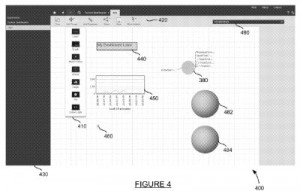 The provision of a user-readable interface through which application performance can be reported is detailed in U.S. Patent Application No. 20150058092, which is titled Dashboard for Dynamic Display of Distributed Transaction Data. It would protect a method for reporting data by providing an interface to a remote device for configuring a report for transaction performance data, receiving an input specifying a filter for displaying a category of entities and reporting dynamically selected performance data for entities that satisfy the filter. This interface improves application performance monitoring while providing more specific information on bottlenecks and communication failures.
The provision of a user-readable interface through which application performance can be reported is detailed in U.S. Patent Application No. 20150058092, which is titled Dashboard for Dynamic Display of Distributed Transaction Data. It would protect a method for reporting data by providing an interface to a remote device for configuring a report for transaction performance data, receiving an input specifying a filter for displaying a category of entities and reporting dynamically selected performance data for entities that satisfy the filter. This interface improves application performance monitoring while providing more specific information on bottlenecks and communication failures.
Following the thread of a business transaction to identify problems in distributed networks is a common theme running through the IP portfolio of AppDynamics, echoed again within U.S. Patent Application No. 20150222505, which is titled Business Transaction Resource Usage Tracking. It discloses a method for monitoring a business transaction by receiving a PHP request, determining a usage of a resource with the PHP request and determining the resource usage by a business transaction which includes a plurality of requests. This system provides more accurate indications of which portion of a web service are not performing well when compared to conventional monitoring systems. The tracking of business transactions through both Java and non-Java frameworks, which may not handle call threads in the same way, is featured within U.S. Patent Application No. 20150319221, which is titled Tracing Business Transactions Based on Application Frameworks. It would protect a method for tracing a distributed transaction which involves detecting a PHP application framework call which is part of a distributed transaction to a remote server, setting a business transaction name associated with the call, modifying PHP framework call with the business transaction name and transmitting the modified PHP framework call to the remote server. This invention provides a technique through which distributed transactions can be monitored when those transactions cannot be traced based on threads.
Techniques for determining the amount of time that an end user must wait to access network resources, such as the time needed to load a web page, are discussed within U.S. Patent Application No. 20150288584, which is titled System and Method for Determining End User Timing. It discloses a method for monitoring a business transaction by capturing a first set of metrics using handler objects in a network browser executing on a computer, comparing the first set of metrics with a second set of metrics retrieved from a browser interface and reporting the most accurate set of metrics from both sets. This system for providing improved end user timing information which is optimal for comparing end user timing over many types of devices and platforms.
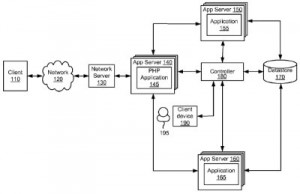 Finally, we were intrigued to take note of a new technology for correcting application performance once an issue has been discovered, which is described within U.S. Patent Application No. 20150067147, filed under the title Group Server Performance Correction via Actions to Server Subset. This patent application would protect a method for monitoring a business transaction by determining that a metric associated with a plurality of nodes of a distributed server system doesn’t satisfy a threshold, applying a first corrective action to a first subset of the plurality of nodes and applying the first corrective action to the remainder of the nodes after detecting that the first subset of nodes satisfies the threshold after the first corrective action is applied. The applying of actions to nodes when a network issue is detected enables application owners to fix an application issue without having to bring the application offline and stop service to customers.
Finally, we were intrigued to take note of a new technology for correcting application performance once an issue has been discovered, which is described within U.S. Patent Application No. 20150067147, filed under the title Group Server Performance Correction via Actions to Server Subset. This patent application would protect a method for monitoring a business transaction by determining that a metric associated with a plurality of nodes of a distributed server system doesn’t satisfy a threshold, applying a first corrective action to a first subset of the plurality of nodes and applying the first corrective action to the remainder of the nodes after detecting that the first subset of nodes satisfies the threshold after the first corrective action is applied. The applying of actions to nodes when a network issue is detected enables application owners to fix an application issue without having to bring the application offline and stop service to customers.

![[IPWatchdog Logo]](https://ipwatchdog.com/wp-content/themes/IPWatchdog%20-%202023/assets/images/temp/logo-small@2x.png)

![[Advertisement]](https://ipwatchdog.com/wp-content/uploads/2024/04/Artificial-Intelligence-2024-REPLAY-sidebar-700x500-corrected.jpg)
![[Advertisement]](https://ipwatchdog.com/wp-content/uploads/2024/04/UnitedLex-May-2-2024-sidebar-700x500-1.jpg)
![[Advertisement]](https://ipwatchdog.com/wp-content/uploads/2024/04/Patent-Litigation-Masters-2024-sidebar-700x500-1.jpg)

![[Advertisement]](https://ipwatchdog.com/wp-content/uploads/2021/12/WEBINAR-336-x-280-px.png)
![[Advertisement]](https://ipwatchdog.com/wp-content/uploads/2021/12/2021-Patent-Practice-on-Demand-recorded-Feb-2021-336-x-280.jpg)
![[Advertisement]](https://ipwatchdog.com/wp-content/uploads/2021/12/Ad-4-The-Invent-Patent-System™.png)






Join the Discussion
One comment so far.
Simon Arira
December 18, 2015 09:04 amIt’s one of a kind indeed, looking at the patent portfolio landscape for most of the unicorn companies: http://www.intellectualpropertymagazine.com/analytics/beware-the-rise-of-the-unicorns-110673.htm